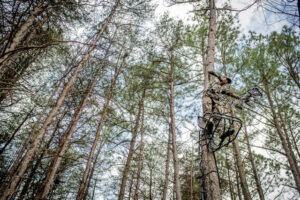Skip to content
14 Tree Stand Hacks For Deer Hunters
 Look for trees for stands at midday, when most does and bucks are bedded. A quiet, rainy day is perfect. Scout with the wind in your face or quartering over your shoulder to keep from spooking bedded deer.
Look for trees for stands at midday, when most does and bucks are bedded. A quiet, rainy day is perfect. Scout with the wind in your face or quartering over your shoulder to keep from spooking bedded deer.- At a new stand site, be quiet. Don’t throw or bang steel or aluminum stands and steps around. If you’re hanging with a buddy, don’t talk or laugh loudly. Set up and sneak out of an area without alerting deer that might be bedded or walking nearby.
- Everybody looks for big, straight trees, but a hardwood that leans slightly back and toward your downwind side can be great. When you hang your stand on the ‘up’ or front side of the tree, it will be comfortable and positioned perfectly for shooting. The wind will be in your face or quartering on.
- It’s always best to hang a stand perfectly level. But when a tree is not truly straight, set the foot platform so that it tips slightly up. When you sit, this raises your knees slightly and makes you comfortable. When you stand to draw and shoot, you’ll be firmer and safer than if the platform were to tip slightly down.
- Sometimes, especially when cover is sparse in the treetops, it can pay to set an evening stand on a tree so that it faces a crop field or food plot. Deer will come from the woods and thickets to the rear, and the tree between you and them will provide good cover.
- If you shoot right-handed, set up where deer will pass within 30 yards to your left (vice versa for southpaws). You can draw and shoot with ease and little movement as a buck quarters past.
- Say two deer trails run down a ridge or through a bottom. Which one will a buck take? Well, make him walk the one that runs closest to your stand. Drag a bunch of branches or a big deadfall into one trail to block it. When a buck comes along he’ll skirt the obstacle and veer over to the trail you’re covering.
- After hanging a stand, look around on the ground and remove any big logs or brushy tops that might block a buck from walking within 30 yards. If the cover is real tight, pull out your hand clipper and cut a small path 20 yards or so on the upwind side of your stand. When you come back to hunt in a few days you should see some fresh tracks in the new, clear trail. .
- You’ll need a clipper and a folding saw to cut out spots for tree stands. A pole extension is a hassle to carry, but it makes your job a lot easier.
- It makes absolutely no sense to hang a stand in a spot where you can’t shoot. You don’t have to cut pulpwood, but trim at least three good shooting lanes to the upwind sides and front of your stand. Drag limbs and brushy tops away so deer won’t smell your scent on them, or so they won’t block a buck’s approach. After cutting, it’s best to sneak out of a spot and rest it for a day or two before hunting.
- You stretch before a jog or a game of softball, right? So why not loosen up before hanging or climbing into a tree stand. At your truck, do some leg, arm and side-to-side torso stretches. The hike into a spot will further loosen you up. You’ll hang and/or climb steps easier and safer.
- Try to hang a morning stand facing somewhere west, and an evening stand pointing toward the east. With the sun at your back, you’ll have great visibility of the woods out front and below. You’ll have the most shooting light at dawn and dusk. You’ll be shaded nicely, lessening the odds that deer will look up and see you.
- Don’t mark your stands with gaudy flagging tape, but with “bright-eye” tacks or wraps. Flash a quick light on your markers as you sneak in or out at dawn or after dark, and you won’t stumble around looking for your stand and spooking deer.
- Never run a climbing stand up a tree, or attempt to set steps and a fixed stand, without wearing a climbing belt/harness. Once 20 feet up and hunting, switch over to a full-body harness.
Page load link
 Look for trees for stands at midday, when most does and bucks are bedded. A quiet, rainy day is perfect. Scout with the wind in your face or quartering over your shoulder to keep from spooking bedded deer.
Look for trees for stands at midday, when most does and bucks are bedded. A quiet, rainy day is perfect. Scout with the wind in your face or quartering over your shoulder to keep from spooking bedded deer.




